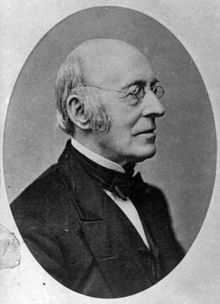New England Non-Resistance Society
The New England Non-Resistance Society was founded at a special peace convention organized by William Lloyd Garrison, in Boston in September 1838.[1] Leading up to the convention, conservative members of the American Anti-Slavery Society and the American Peace Society expressed discomfort with Garrison's philosophy of "non-resistance" and inclusion of women in public political activities. After conservative attendees opposing Garrison walked out of the convention in protest, those remaining formed the New England Non-Resistance Society.

In the Society's “Declaration of Sentiments” Garrison wrote, "any person without distinction of sex or color, who consents to the principles of this Constitution may become a member and be entitled to speak at its meetings."[1] Twenty of the forty-four signers of the Society’s Declaration were women.[2]
The Society condemned the use of force in resisting evil, in war, for the death penalty, or in self-defense, renounced allegiance to human government, and because of the anti-slavery cause, favored non-union with the American South. Edmund Quincy (1808-1877), Maria Weston Chapman and William Lloyd Garrison, published the Non-Resistant (1839 - 1840), which lasted only two years but was indicative of the millennial character of parts of the reform movement.[3]
Among the members were Adin Ballou, Amos Bronson Alcott, Maria Weston Chapman, Stephen Symonds Foster, Abby Kelley, Samuel May, Parker Pillsbury, and Henry C. Wright.
Notes
- ↑ 1.0 1.1 Peter Brock Pacifism in the United States, from the Colonial era to the First World War. Princeton, N.J., Princeton University Press, 1968, pp. 539-42.
- ↑ Yellin, Jean Fagan. 1994. The Abolitionist Sisterhood: Women's Political Culture in Antebellum America. Philadelphia: Library Company of Philadelphia.
- ↑ Malone, Dumas, ed. 1935. Dictionary of American Biography, Vol. VIII, pp. 306-07. New York: Scribner's.